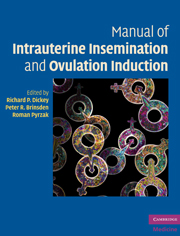Book contents
- Frontmatter
- Contents
- List of contributors
- Preface
- 1 An overview of intrauterine insemination and ovulation induction
- 2 Male causes of infertility: evaluation and treatment
- 3 Female causes of infertility: evaluation and treatment
- 4 Clinic and laboratory design, personnel and equipment
- 5 Semen analysis: semen requirements for intrauterine insemination
- 6 Semen preparation for intrauterine insemination
- 7 Ovulation induction for intrauterine insemination I: oral drugs clomiphene, tamoxifen, letrozole
- 8 Ovulation induction for intrauterine insemination II: gonadotropins and oral drug–gonadotropin combinations
- 9 Ultrasonography in the management of ovulation induction and intrauterine insemination
- 10 Insemination technique and insemination complications
- 11 Cryopreservation
- 12 Donor sperm
- 13 The role of the nurse in intrauterine insemination and ovulation induction
- 14 Complications of ovulation induction I: high-order multiple births, miscarriage, ectopic pregnancy, congenital anomalies, ovarian cancer
- 15 Complications of ovulation induction II: ovarian hyperstimulation syndrome, ovarian torsion
- 16 The psychological issues of intrauterine insemination
- 17 Ethical, legal and religious considerations of artificial insemination
- Index
14 - Complications of ovulation induction I: high-order multiple births, miscarriage, ectopic pregnancy, congenital anomalies, ovarian cancer
Published online by Cambridge University Press: 01 February 2010
- Frontmatter
- Contents
- List of contributors
- Preface
- 1 An overview of intrauterine insemination and ovulation induction
- 2 Male causes of infertility: evaluation and treatment
- 3 Female causes of infertility: evaluation and treatment
- 4 Clinic and laboratory design, personnel and equipment
- 5 Semen analysis: semen requirements for intrauterine insemination
- 6 Semen preparation for intrauterine insemination
- 7 Ovulation induction for intrauterine insemination I: oral drugs clomiphene, tamoxifen, letrozole
- 8 Ovulation induction for intrauterine insemination II: gonadotropins and oral drug–gonadotropin combinations
- 9 Ultrasonography in the management of ovulation induction and intrauterine insemination
- 10 Insemination technique and insemination complications
- 11 Cryopreservation
- 12 Donor sperm
- 13 The role of the nurse in intrauterine insemination and ovulation induction
- 14 Complications of ovulation induction I: high-order multiple births, miscarriage, ectopic pregnancy, congenital anomalies, ovarian cancer
- 15 Complications of ovulation induction II: ovarian hyperstimulation syndrome, ovarian torsion
- 16 The psychological issues of intrauterine insemination
- 17 Ethical, legal and religious considerations of artificial insemination
- Index
Summary
Parallel to the great progress achieved during the last two decades in the therapeutic induction of ovulation was an increasing incidence of the two main complications associated with this kind of treatment, namely, ovarian hyperstimulation syndrome (OHSS) and multiple pregnancies.
Schenker et al. 1981Multiple births
All multiple births are associated with significant neonatal, maternal and family morbidity, but this is particularly so for triplet and higher-order multiple births (HOMB). Ovulation induction (OI), outside of in-vitro fertilization (IVF), is estimated to be responsible for 20% of twins, 40% of triplets and 70% of infants live born in quadruplet and higher-order deliveries in Western nations. On average 10% of births resulting from clomiphene (CC) will be twins, and less than 1% of births will be triplets and HOMB. These figures increase to 20% and 8% respectively for births resulting from gonadotropins. For younger patients who are high responders, the incidence of triplet and higher-order pregnancies (HOMP) can be 20%. Nearly all HOMB due to OI with gonadotropins in controlled ovarian hyperstimulation (COH) protocols might have been prevented by use of lower doses of gonadotropins, with very little reduction in the number of patients able to conceive. The majority of women who require OI will be able to become pregnant within 3-6 cycles of single or double follicular development using oral drugs or low-dose gonadotropins, with a 10% chance of twins and less than a 1% chance of HOMB.
- Type
- Chapter
- Information
- Manual of Intrauterine Insemination and Ovulation Induction , pp. 141 - 150Publisher: Cambridge University PressPrint publication year: 2009



